

Dec 8, 2023
TECH & DESIGNTo Achieve Environment-friendly Manufacturing through the Smart Use of Energy
— Examples of two departments at DENSO toward DX of manufacturing plants
DENSO Tech Links #18 featured lectures by engineers and a panel discussion with a special guest regarding the future of monozukuri (manufacturing) envisioned by DENSO on the theme of digital transformation (DX) at manufacturing sites. Mr. Matsutani of the Electrification Systems Monozukuri Development Div..and Mr. Arai of New Domain Products Production Eng. Dept.. explained how their departments are working toward DX of manufacturing plants.
-

New Domain Products Production Eng. Dept., Mechatronics Systems Manufacturing Div. DENSO CorporationHiroaki Arai
-

Production Engineering & Development Dept. 1, Electrification Systems Monozukuri Development Div., DENSO CorporationIsao Matsutani
Contents of this article
Self-introduction of Isao Matsutani
Isao Matsutani:I will explain the example of our department. First, let me introduce myself. I’m Isao Matsutani of the Electrification Systems Monozukuri Development Div. I’m in charge of the development of manufacturing technologies and production lines for electrification products.
I joined DENSO in 2006, and I work in the production engineering section, where Mr. Hiroaki Arai also works. I used to be involved in prototype production and the development of elemental technologies and mass production, but now I’m in charge of the development of production systems.
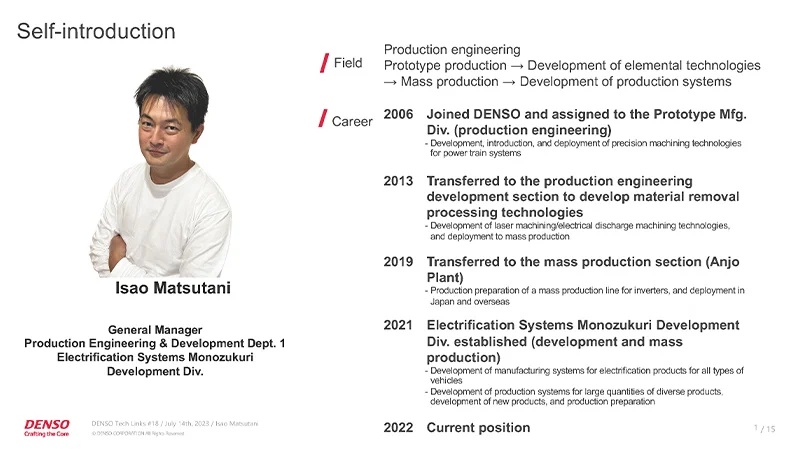
The mission of our department is to keep the world’s air and skies clean by electrifying all types of vehicles using our electrification products. The term “vehicles” includes cars, trucks, motorcycles, and aircraft.
To quickly deliver these electrification products to all customers, it is necessary to quickly establish production lines. The production systems must be carbon-neutral, and we have been working toward this goal.
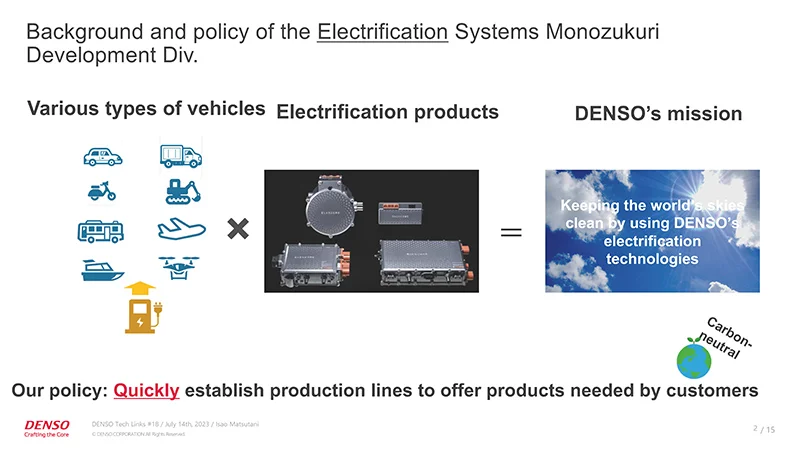
Steps to Building Equipment and Establishing Production Lines
Next, I’ll explain how we establish production lines quickly. I’ve been told that not all participants here today are experts in manufacturing, so first I’ll outline the steps to building equipment and establishing production lines.
The preparation of equipment and production lines consists of four phases: study, specifications, fabrication, and start-up. In the study phase, we consider the sequence and the processing method to manufacture products. In the specifications phase, we draw simple pictures, which resemble cartoons, to determine how to embody the processing method. These pictures are sent to equipment building experts, who prepare detailed design drawings.
We must convey our intentions clearly to enable these drawings to be prepared. Lack of communication results in rework.
When building equipment, components are manufactured and assembled. The completed equipment often causes problems such as not being easy for users, resulting in rework.
When a piece of equipment is completed, many pieces are arranged to create a production line. However, adjustments require many operators.
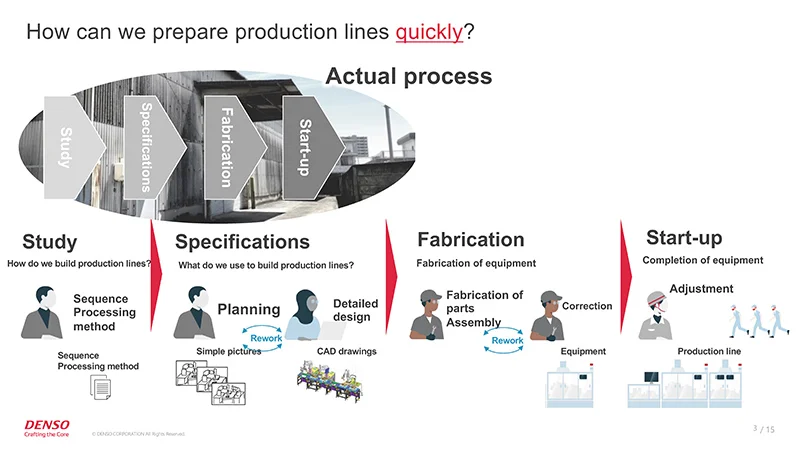
We are considering ways to eliminate rework, which incurs additional time, by using cyberspace and thereby accelerating the development.
Unique Arrangements in Each Phase
Next, I will explain unique measures taken in each phase, namely, study, specifications, fabrication, and start-up.
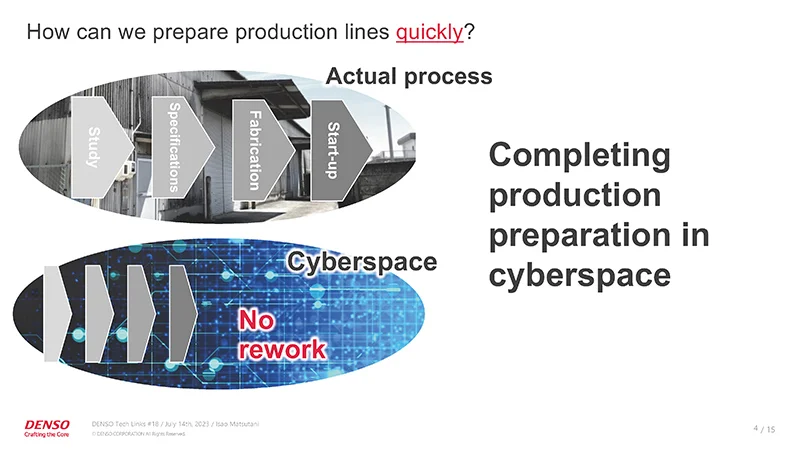
Regarding the study and specifications, we have been manufacturing inverters for many years and so have a lot of equipment data. We have a catalog in which various types of equipment are categorized by function.
When we create equipment and examine the specifications, we simply select manipulators, stands or bases, conveyors, and tools. Detailed drawings can then be easily prepared, just like building LEGO bricks. This helps eliminate rework.
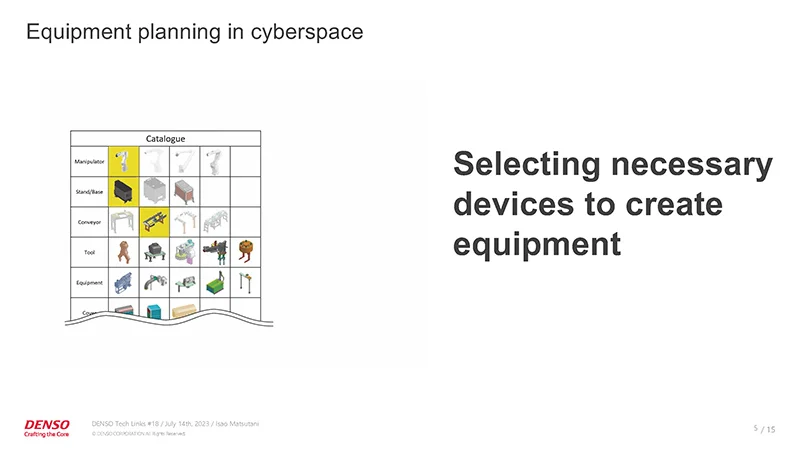
Then, the models are used to operate in cyberspace, where we can create programs without actual equipment. These arrangements help slash the time required.
(While pointing to the slide) When two manipulators are placed close to each other as shown on the slide, they are likely to hit each other and be damaged. Great care is required, and such teaching is time-consuming. In cyberspace, such problems can be avoided, which speeds up the development.
Development of a Production Line
Having talked about equipment, I’d now like to show a video which explains how a production line is created.
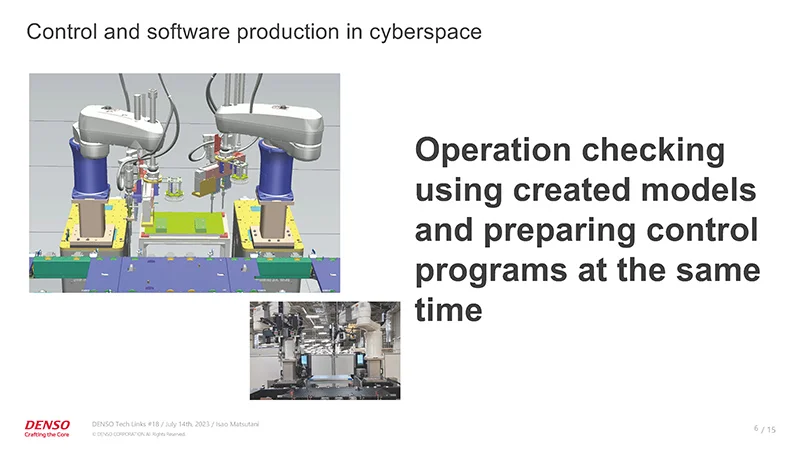
Models of equipment, which I explained earlier, are placed like LEGO bricks, and control programs and materials are also arranged in cyberspace. In this way, a production line that can be operated is built in cyberspace.
The number of production lines is increased as necessary. An entire plant can be created in cyberspace by arranging necessary auxiliary systems and equipment. You can see how the plant operates. We can then identify stagnant points or improvement points, and refine the design before fabrication.
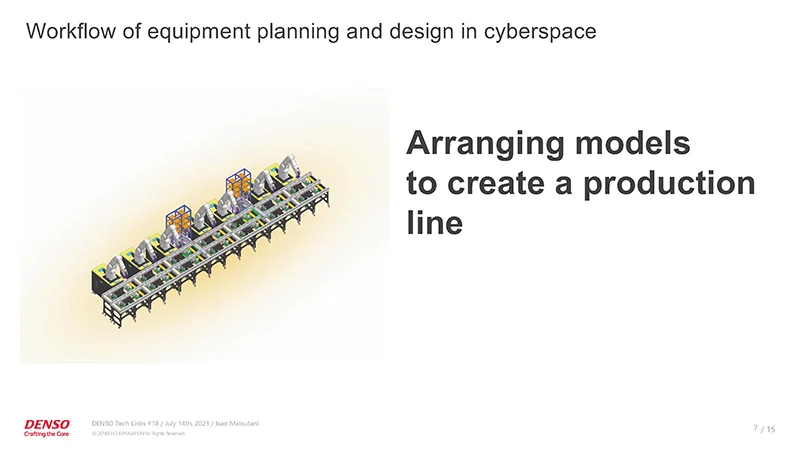
Regarding processes that require special consideration such as user friendliness and safety, we go into cyberspace to check the details. (While pointing to the video) The video in the lower left shows two associates holding a discussion in cyberspace; they are not pantomiming. We display models, conduct investigations, and reflect our knowledge and special considerations.
This work can be done anywhere in the world with just a headset, digital data, and an Internet connection. We go through this process repeatedly with global associates to quickly enhance quality.
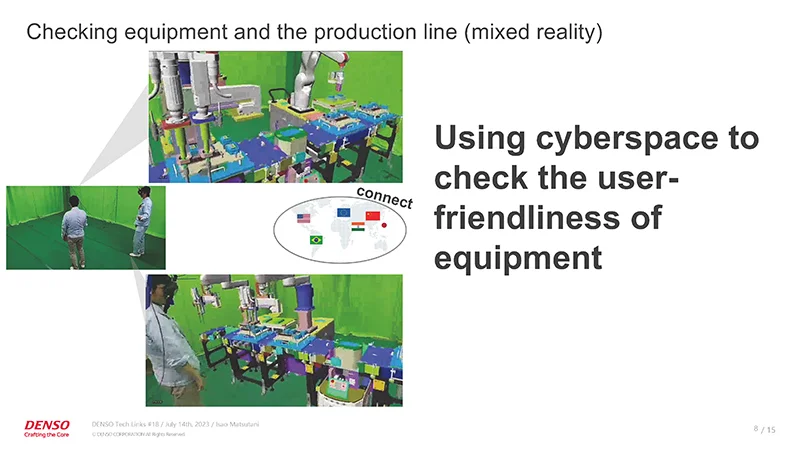
The next step is to run the production line, determine the production speed, and identify stagnant points.
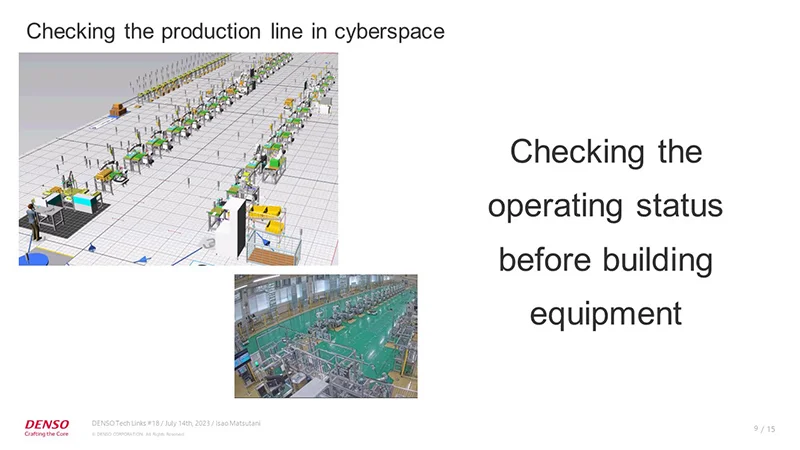
We shoot a video of the overall production line to check the situation at the same time. This helps speed up development further. By using cyberspace, we can significantly reduce the time required for production preparation.
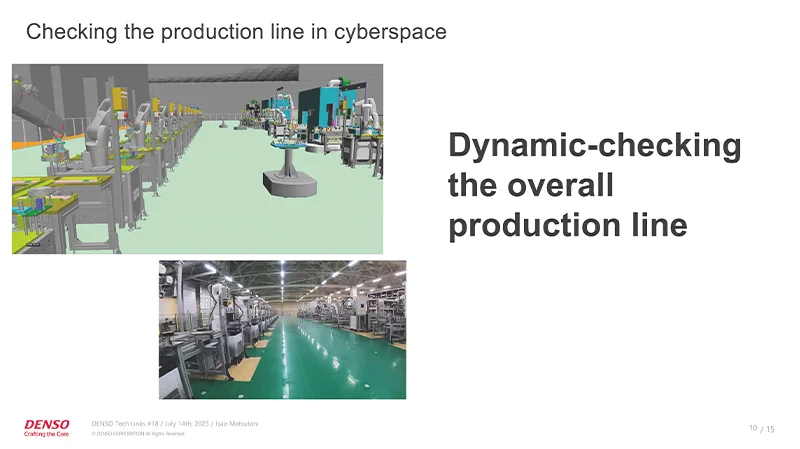
Two Means to Achieve Carbon Neutrality
Next, I will talk about carbon neutrality. The term “carbon neutrality” as used in the manufacturing industry may sound like energy conservation activities, which are obviously important. Here, I will explain our manufacturing vision by using digital technologies.
Today, we operate our plants using energy, including grid power, solar power, and wind power. In the future, we hope to operate our plants by using our natural energy alone to ensure business continuity planning (BCP) and achieve more environment-friendly manufacturing.
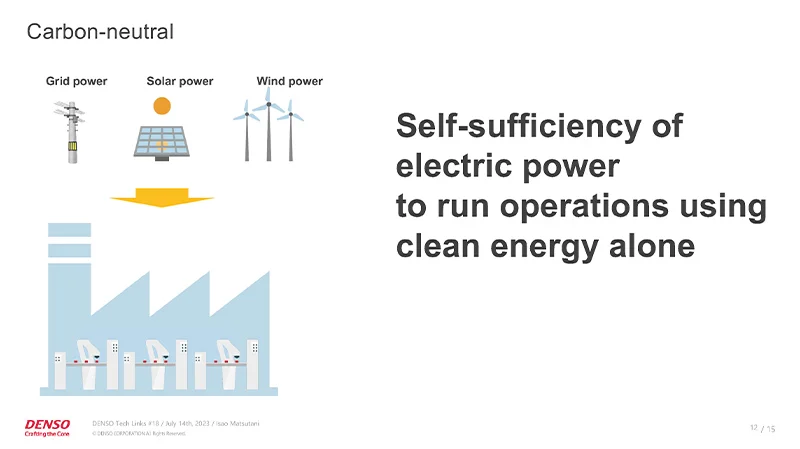
Huge investments in infrastructure would be required if only current technologies were used. It would be totally impossible to achieve the vision.
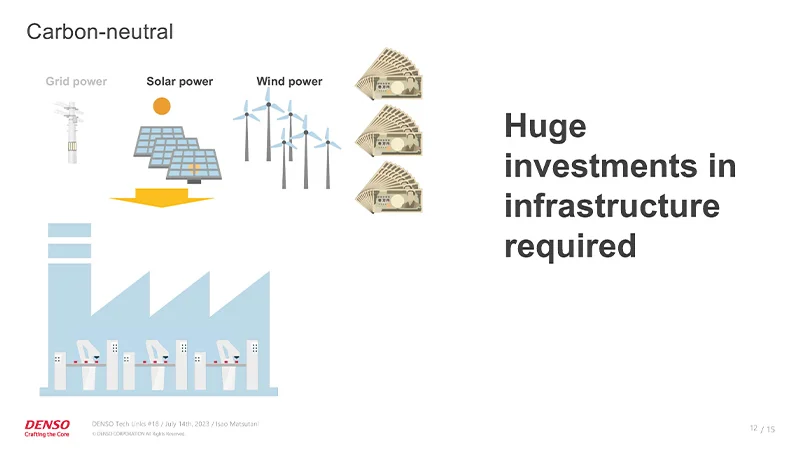
This slide shows the vision that we hope to realize through the smart use of energy. I’ll explain two ways of achieving this vision.
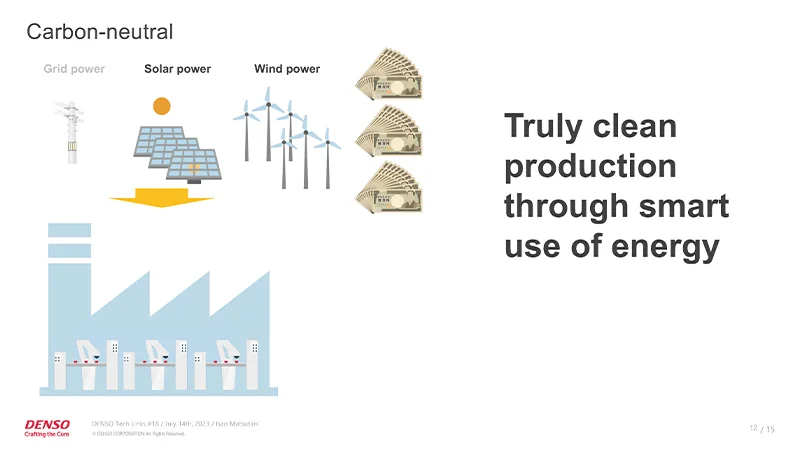
We record the operation data of our plants in real time, including the movement and power consumption of equipment.
By analyzing the data, we can find, for example, that energy consumption is high because equipment is running. In order to use natural energy to cover this high energy consumption, we would need to invest in natural energy.
But if we can shift the peak load of energy consumption, we can reduce investments in infrastructure and thus achieve the vision I mentioned earlier. The illustration looks very simple, but it is necessary to determine the equipment subject to peak-load shifting and calculate the timing and the shifting amount under various conditions. This cannot be done manually. We aim to attain this vision by using digital technologies and AI technologies.
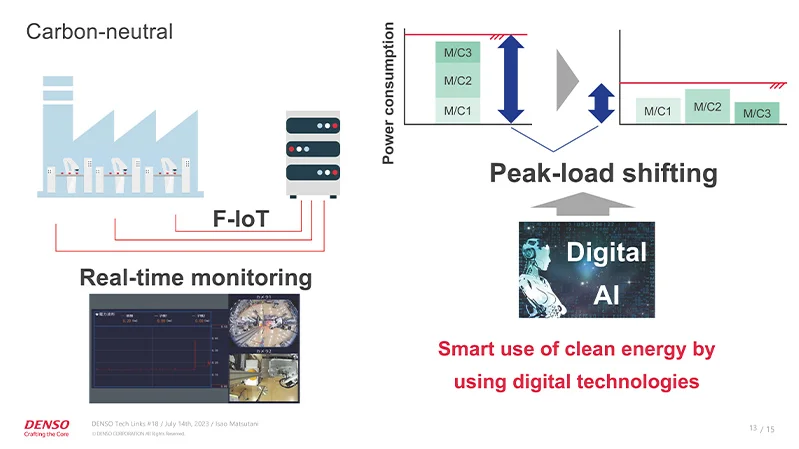
We continue to obtain data by linking the movement with power consumption. The data enables us to calculate the CO2 emissions before building production lines or manufacturing products and simulate each piece of equipment which is used to run the production lines. The data is also linked with products, which determine the equipment operation.
By establishing linkages, we can develop technologies for CO2-free manufacturing from the design phase, even before manufacturing products.
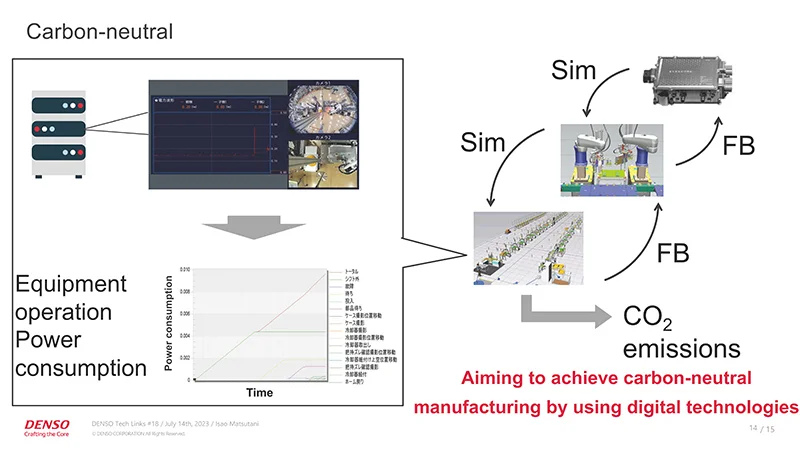
Here is the wrap-up. I have talked a lot about cyberspace, which is the new proving ground for engineers. We hope to test new ideas and demonstrate creativity in cyberspace to change the world. Digital technologies are the tools for this purpose. Let’s use cyberspace together to improve our manufacturing operations.
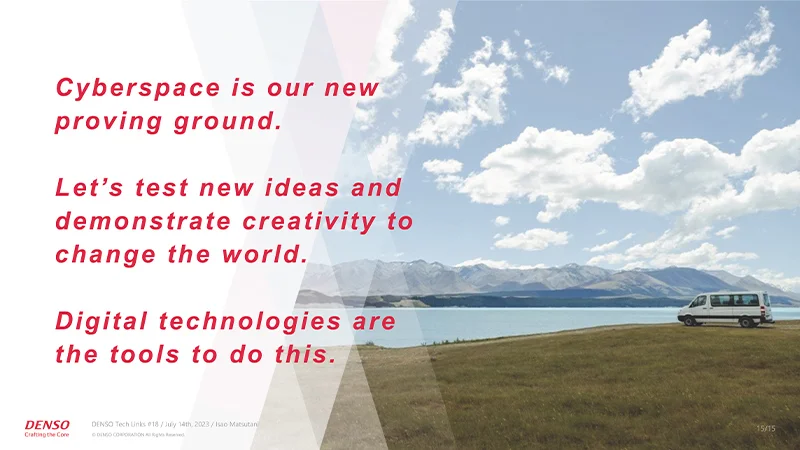
That’s all for my presentation. Mr. Arai will now give a presentation on the second example.
Production Lines with Production Systems That Can Manufacture Any Product
Hiroaki Arai:I will explain the example of the Mechatronics Systems Manufacturing Div. Our division manufactures various products that enhance the value of the basic vehicle functions: driving, turning, and stopping. As I mentioned earlier, we develop various products in the “Green”, “Peace of Mind”, and “Society” domains in line with the mobility revolution.
In new businesses such as EVs, it will be difficult to predict which and how much products will sell. We will cope with such uncertainty by developing production systems capable of manufacturing any product.
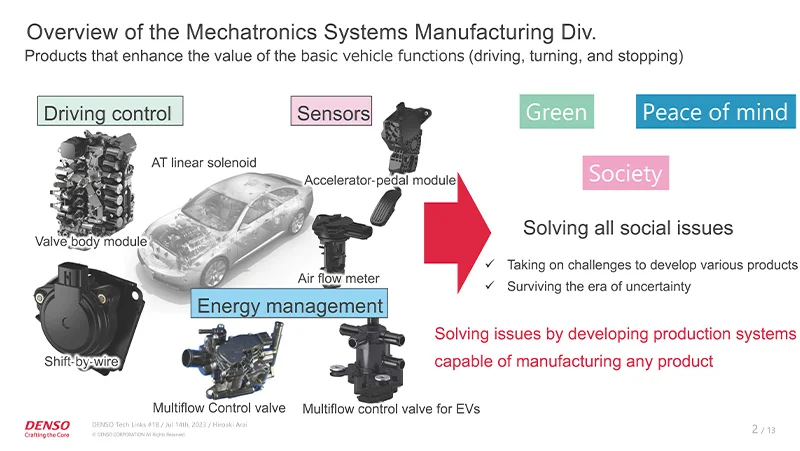
This means that the product shape varies, but the process elements are the same. Any product can be manufactured by rearranging the processes. To achieve this, it is necessary to standardize and modularize elemental units and design units on the assumption that they will be rearranged.
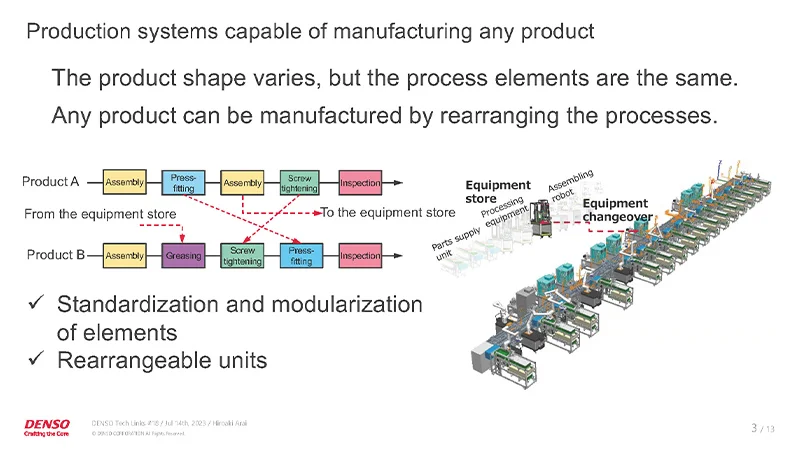
(While pointing to the slide) This production line embodies such concept. It achieves fully automatic assembly using robots. The width, depth, and interface of the units are standardized, and the units can be lifted and transported. To transport equipment, an automated guided vehicle shown on the right enters the space under the equipment to lift it, thereby disconnecting the equipment and enabling automatic transfer.
To cope with the positional deviation caused by rearrangement, the reference mark is scanned by a camera on the robot. The position is then automatically corrected to achieve highly accurate assembly.
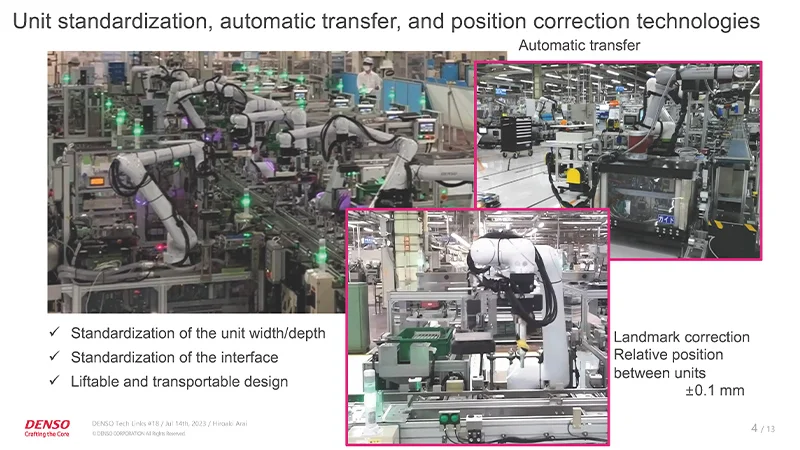
We develop such production lines by digitalizing the process design and verification workflow, as I mentioned earlier. We have found that good results require an enormous amount of work.
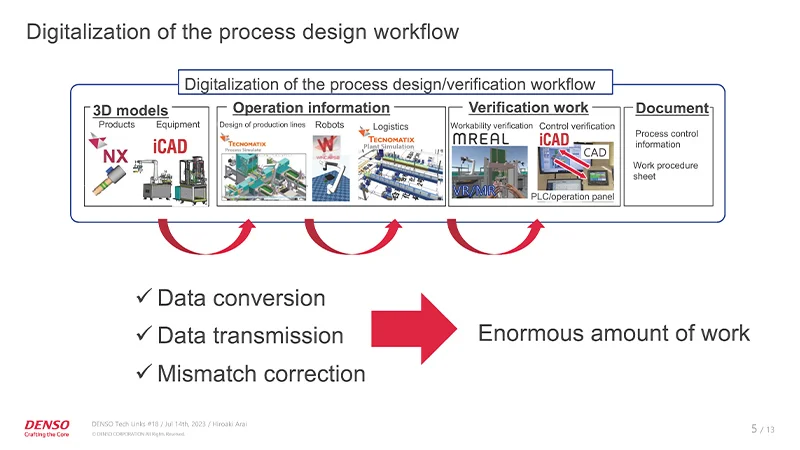
Solutions Offered by Omniverse
A platform called Omniverse has been introduced to enable multiple associates to work together while using various tools in real time.
Real-world data, such as differences in the robot operation and surface texture, is reflected in cyberspace. The scope that cannot be reproduced in cyberspace is corrected in the real world. Thus, we aim to create an environment where objects designed in cyberspace can be easily operated in the real world.
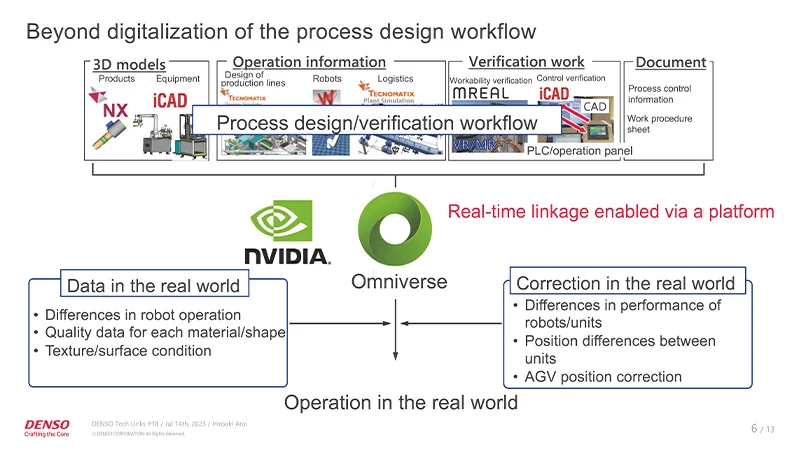
For example, Omniverse presents visuals that are as vivid as pictures. The layout and color of objects can be changed in cyberspace to enable 3D computer aided design (CAD). Parts can be removed to look inside equipment.
A scanner, which is a special device, can be used to scan the surface texture of objects and gather data, which is reflected in Omniverse to reproduce the texture that cannot be created by CAD. We also use a platform, which is another feature of Omniverse, to link various tools in real time.
Use of Digital Solutions in Production
Next, I will explain the use of digital technologies in production. (While pointing to the slide) At a plant in the real world, various conditions are monitored by using sensing devices to gather data. Simulations are conducted as shown on the left to optimize production plans, and feedback is given to the plant in the real world.
As shown on the right, when abnormalities occur during production, equipment operation and troubleshooting are performed remotely to continue production automatically. This is the vision we hope to fulfill. Today, I will explain visualization of production conditions, remote control of equipment, and remote troubleshooting.
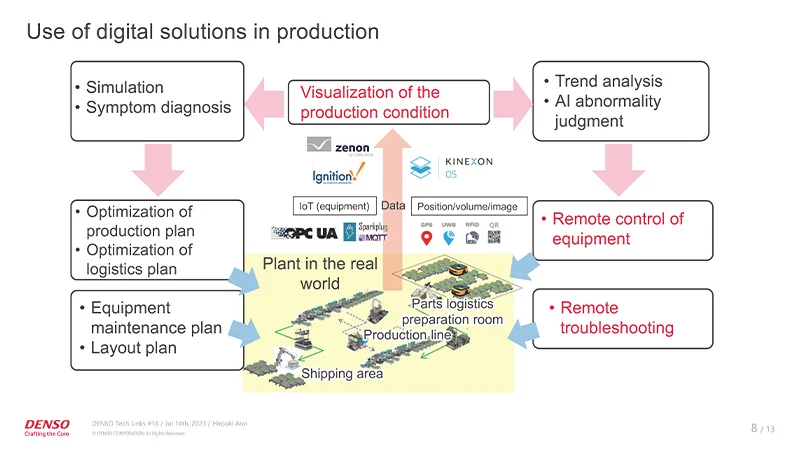
Regarding visualization, simulated operation of robots is reflected in the operation of actual equipment. The operation of actual equipment can be reproduced in cyberspace. This helps create an environment where the movement can be visually checked in addition to data.
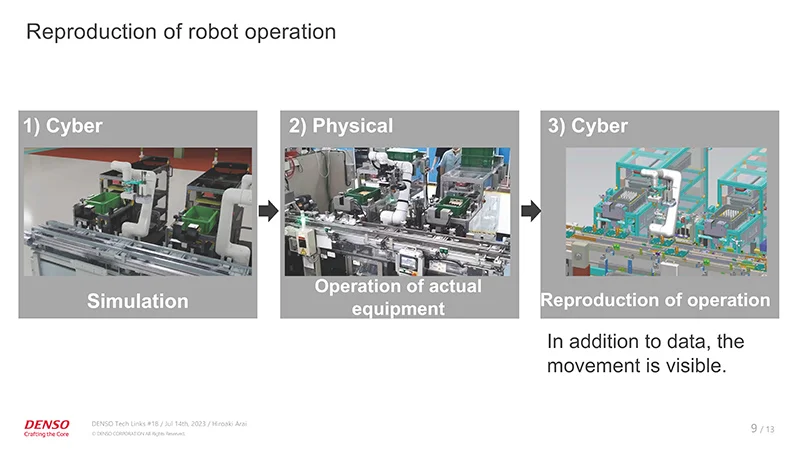
Previously, operators had to operate equipment on site. As shown on the left, a system named Zenon makes it possible to link with equipment via a smartphone. The figure on the right shows a system named KINEXON, which links with the position information of operators and objects. There is a mechanism to control equipment when an operator enters the monitoring area.
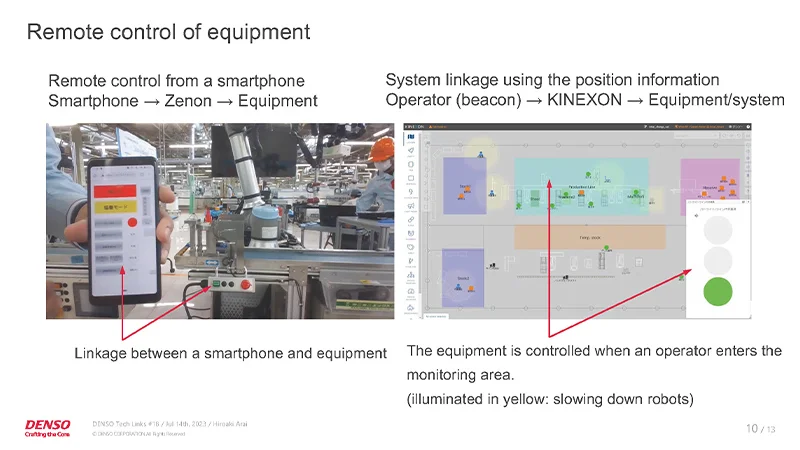
It is sometimes necessary to deal with objects on site such as dropped parts. In such cases, a robot travels to the site to pick up such parts. A robot can be operated intuitively by converting the movement of a human hand to the operation of the robot.
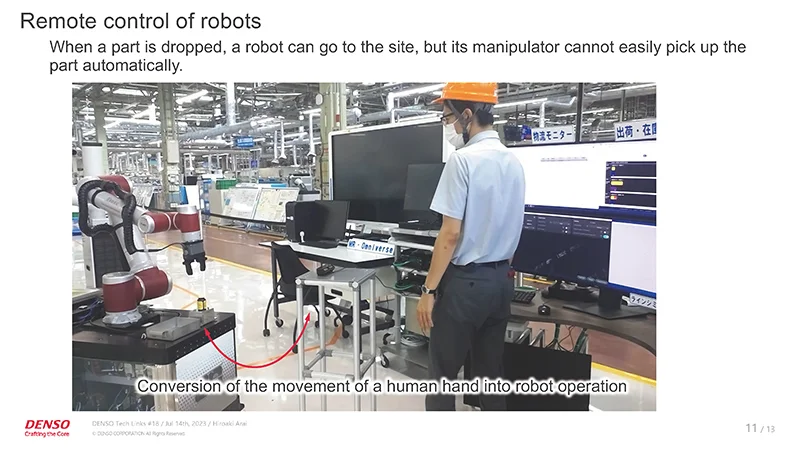
Messages from Young Engineers
Finally, I would like to introduce messages from young engineers.
(The video starts.)
Haruki Nakagawa:I’m Haruki Nakagawa. I joined DENSO in FY2020, and I’m developing assembly robot technologies that go beyond human capabilities. I have found that movements that are easy for people to perform are more complicated for robots than I expected. This is a difficult part of my work, but I gain a real sense of fulfillment when the technologies I have developed are used in actual production. I hope to work with people who enjoy working on new business without hesitation.
Kota Enomoto:I’m Kota Enomoto. I joined DENSO in FY2018, and I am developing software for controlling new domain production systems. It is extremely difficult, even for experts, to develop these systems. It’s thrilling when I see a system operate as I designed. I hope to develop systems that integrate production equipment with IT by taking full advantage of my knowledge.
(The video ends.)
Arai:This is the end of my presentation. I hope to work with new members and tackle challenges together toward our grand vision. Please join me. Thank you very much.
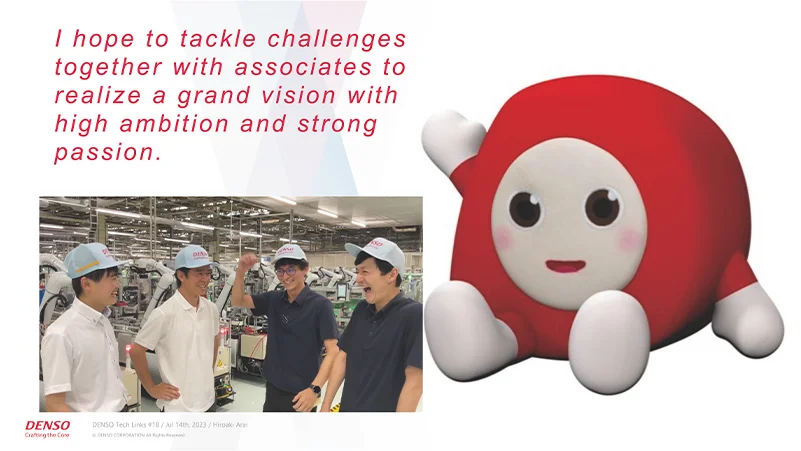
REACTION
Changing your "Can'ts" into "Cans"
Where Knowledge and People Gather.




Leave a comment